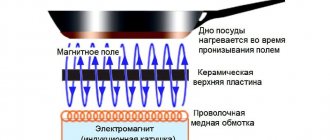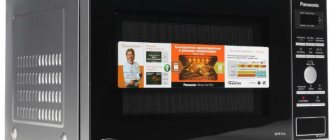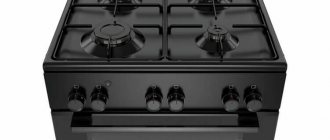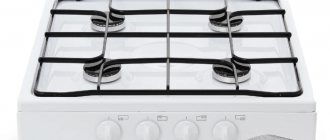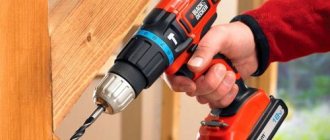Those who decide to install a new hob in their kitchen often think about purchasing an induction model. Many users have heard that such surfaces use energy more economically, do not heat up during operation, and allow you to cook very quickly. But the high price of this technical miracle and many myths about the dangers of electromagnetic induction for humans stop it. Let's try to understand the operating features of an induction hob, its advantages and disadvantages over conventional electric stoves, as well as the main parameters that should be taken into account when purchasing it.
Advantages of induction hobs
- Induction panels can significantly save time spent on preparing lunch. They actually heat up much faster than other types of stoves. Speed is perhaps one of their main advantages.
- Induction is characterized by a lightning-fast reaction to any changes in settings. A decrease or increase in heating occurs immediately after adjustments are made to the mode. We can say that ideal conditions have been created for preparing dishes of any complexity.
- The glass-ceramic surface itself practically does not heat up when the stove is in operation - only the pan standing on it heats up. This means that the risk of getting burned is minimized.
- Induction hobs are very energy efficient. Among kitchen stoves they have the highest efficiency.
- In terms of the functionality they contain, modern induction panels are undoubtedly the leaders among cooking appliances.
- The induction hob combines advanced technologies for reliability and durability, intuitive controls and a stylish, cutting-edge design.
Agree, there are many advantages. And if the high price of this miracle, as well as myths about the dangers of electromagnetic radiation, do not stop you, get ready to go to the store.
Comparison of induction and electric cookers
| Characteristics | Induction cooker | Electric stove |
| Suitable cookware | Special dishes with ferromagnetic properties | Dishes with a perfectly flat bottom |
| Heating rate | Almost instantly | From 7 to 20 minutes |
| Efficiency | About 90% | About 60% |
| Economical | Consumes less electricity and costs less | Consumes a lot of electricity |
| Safety | The hob is safe for children and animals | Poses a risk of fires and burns |
| Noise | Quite quiet sounds, humming | Silent |
| Care | Liquids and food can be easily removed with a damp cloth | Dirt is difficult to remove |
| Control | Automatic switching on, touch control | Mechanical or touch activation and regulation |
Based on the above table, we can conclude that a modern induction cooker is a choice in the direction of convenience, safety and functionality.
Of course, an electric hob is also suitable for use, but it will not save the time and patience of housewives as much as an induction cooker will.
Operating principle of induction hobs
What determines the main distinctive qualities of induction cookers - high heating speed, quick response to changes in settings, relatively low energy consumption? How do induction panels generally differ from other cookers? First of all, the principle of operation.
An induction panel, unlike other types of panels, does not have a heat source. For a gas burner, this source is the flame formed during the combustion of gas; for an electric stove, it is a heating element that heats up when an electric current passes through it. You won't find anything resembling heating elements inside the induction hob. Under its glass-ceramic surface there are induction coils, which heat up only slightly when the stove is turned on.
Induction hob device
1. Temperature sensors. 2. Aluminum bracket.
3. Ferrites. 4. Coil wiring.
5. Induction coils (burners). 6. Control panel.
Despite the slight heating of the coils, water in a pan standing on a cold hob boils quite quickly. Miracle? No, it's a law of physics. The fact is that when alternating electric current passes through the turns of copper wire that make up the induction coil, an alternating magnetic field appears around the coil.
The field generates an eddy induction current in any metal objects in the immediate vicinity, including the iron bottom of a pan standing on the stove. Under the influence of these currents, the pan heats up, and after it, its contents.
Thus, the conversion of electrical energy into heat occurs not somewhere in the inside of the burner, but directly in the walls of the cookware. The absence of a heat transfer stage is responsible for the main advantages of an induction cooker - fast heating and low heat loss.
Watch a video demonstrating the operating principle of an induction hob:
Is induction hob harmful to health?
Many people believe that induction hobs are harmful to human health. Basically, people have this attitude towards these surfaces due to the non-standard nature of its heating principle and a lack of understanding of how it works. However, this is not true. Electromagnetic radiation from such a panel is no more harmful than telephone radiation. Food cooked with it also does not become more harmful. The magnetic field has no effect on it.
Such surfaces are absolutely safe if used correctly:
- Follow the operating instructions.
- Use special dishes.
- Don't stand near the stove all the time.
- Do not lean closer to the panel than 30 cm.
- Ventilate the kitchen regularly.
Don't be afraid of these panels. You should decide whether to buy or not to buy based on the pros and cons of an induction cooker.
Dependent and independent hobs
No matter how strange it may sound, before choosing an induction hob, you should decide whether you need an oven? The fact is that the hob and oven can be independent and dependent.
The first ones are completely autonomous. They have separate controls and connections and therefore can be located anywhere, even at different ends of the kitchen. If you wish, you can purchase devices from different manufacturers. You can even buy a cooktop and skip the oven.
Independent induction hob.
The latter, as the name suggests, are completely dependent on each other. They have a common control unit and are connected to each other, which means that there is only one option for installing them - a hob above the oven. Both devices must be from the same manufacturer. Although such copies are sold separately, it makes sense to purchase them only in pairs.
Dependent induction hob.
Thus, the first step in choosing an induction panel will be to decide whether it is autonomous or, on the contrary, dependent on the oven.
Tips for choosing
- The power of household appliances is a fundamental factor when choosing a device - optimal 2 kW for 1 burner. Accordingly, the higher this indicator, the more efficiently the equipment works.
- When choosing the type of plate control, you should select models with a touch type that is inferior to the magnetic type.
- Compact dimensions save space in the kitchen space. Small rooms should select equipment representatives with diamond-shaped burners, suitable for corner installation.
- The presence of stable, rubberized legs is the key to safe use if the device is a desktop type.
- The complete set of products is important when equipping a model with an oven.
- The warranty period provided by the manufacturer must be at least 12 months. Verified factories certify products.
- Before paying for your purchase, check the functionality of the design.
Watch a video about induction cookers
How to decide on the number of burners, their shape and size
Different models of induction cookers can be equipped with a different number of burners, and the latter can be of different sizes and shapes. How to decide on these parameters?
Required number of burners
The number of burners for different induction panels can vary from 2 to 6. However, there are also models with one burner - compact portable stoves or built-in modules of the “domino” system.
A stove with how many burners should you prefer? This depends primarily on the size of your family, which means how often and how much you will cook and fry. If you have a small family and/or prefer to eat out, there is no point in spending money on a full-size appliance. The more heating zones your induction hob has, the more dishes you can cook at once.
Induction panels with two heating zones are usually purchased by bachelors and childless couples. Stoves with 2-3 burners are preferred by owners of small kitchens: on the one hand, this is quite enough to accommodate everything you need, on the other hand, it will not clutter up the already cramped space.
Panel with two burners.
Models with 4 heating zones are the most common and popular option: on such a hob you can simultaneously cook the first and second courses and boil the kettle.
Panel with four burners.
And finally, if you have a large family or you simply love to cook and devote all your free time to this hobby, purchase a hob with 5-6 heating zones. However, be prepared for the fact that such full-size appliances will take up quite a lot of space in your kitchen.
Panel with six burners.
As for the arrangement of burners on the hob, manufacturers have long moved away from the standards and, in addition to the usual square placement, offer other, most unusual options. Today you can find models in which the heating zones are located in one row, or in a triangle, or in a semicircle - it all depends on the shape and size of the stove.
A panel with a non-standard arrangement of burners.
When choosing an induction hob with a particular burner arrangement, try to evaluate how convenient it will be for you to use this appliance. You should be able to easily reach the cookware no matter which burner it is on. In addition, pots and pans placed on adjacent heating zones should not interfere with each other.
Dimensions and shape of burners
An equally important criterion for choosing an induction hob is the size of the burners. According to this parameter, they should approximately correspond to the size of the dishes available in your home.
If the bottom of the pan does not cover 70% of the heating zone, the stove will not turn on.
Typically, the diameter of the burners on induction panels ranges from 14 to 21 cm. It is more convenient when the stove has burners of different sizes, respectively designed for different containers. The most “advanced” (and therefore expensive) models of induction panels are capable of automatically expanding or narrowing the heating zone, adjusting it to the size of the bottom of the cookware placed on the hob.
The boundaries of the heating zone are usually outlined on the glass-ceramic surface. Moreover, this is not always the usual circle; you can often see squares, hexagons or rhombuses. In this case, the shape is more of a purely decorative function - all these burners are the same in operation.
The designation of heating zones on the hob may differ for different models. For some, this means highlighting the boundaries of the burner with color, for others it is just a cross marking the center of the zone, while others even have a plain surface. On expensive panels, sometimes along the contours of the burners you can even see displays that reflect the power of the heating zone at the moment and the time remaining until the end of the process.
Options for designating heating zones
Features of choosing dishes
An induction cooker requires the use of special cookware. This is directly related to the principle of induction: the device of the stove is similar to a transformer from physics lessons, only the primary winding is a coil, and the secondary winding is a cookware.
Cooking on an induction hob can only be done in containers with a ferromagnetic bottom.
Manufacturers mark it with a special sign in the form of a spiral, and today a set of induction cookware can be purchased in almost any specialized store.
You can check whether your frying pan or pan is suitable for an induction cooker using a magnet: if it sticks to the bottom, then you can safely use it.
If you place the wrong container on the burner, the stove simply will not work. During cooking, only the bottom of the pan and, accordingly, the food in it are heated, but not the cooking surface. Therefore, if a piece of food falls on the burner, it’s okay. The whites won't curdle, the onions won't burn, and you won't have to struggle to scrape off the coals.
When choosing dishes, you should definitely pay attention to its bottom, which should be smooth, without dents or bulges. Manufacturers recommend selecting cookware so that the diameter of the bottom matches the diameter of the burner: the smaller the pot or frying pan, the less power it will have.
What if you are used to drinking Turkish coffee freshly brewed in the morning? Then you will have to additionally purchase a special adapter - a metal adapter disk that will cover the surface of the burner.
duhovka.vyborkuhni.ru
This disc allows you to cook food in regular cookware not intended for induction cookers. However, it is hardly convenient to use it on an ongoing basis. Firstly, adapter manufacturers do not recommend turning on the stove at maximum power, which already limits your dishes. Secondly, you still won’t have enough of one disk to simultaneously cook several dishes on different burners. It is advisable to think about purchasing it if you really have a need to use small dishes at low or medium power. For example, for brewing coffee or heating milk.
How to choose the hob size
The size of an induction cooktop is determined by the number, shape and location of the burners. The minimum width of the stove offered by manufacturers today is 30 cm. This “baby” stove with two burners is an ideal solution for a tiny kitchen. A stove with 3-4 burners is 45-60 cm wide, and an 80-centimeter panel can accommodate 6 heating zones.
The thickness of the induction panels may also differ, although not so much. As a rule, this figure lies in the range from 60 to 80 mm, although there are models that are thinner (up to 40 mm) and thicker (up to 100 mm).
Before choosing an induction hob, either built-in or free-standing, make sure that its dimensions are ideal for your kitchen set.
Fans of non-traditional options need to consider this issue especially carefully, in particular those who decide to buy not a standard rectangular or square hob, but, say, a hexagonal one.
Induction hob of non-standard shape.
Types of induction cookers
Each person is individual, and the same slabs will not suit everyone. But induction can be chosen to suit everyone's needs. There are already a large number of induction cookers that have different characteristics: from large and very functional to small and convenient in everyday life. In addition, they have different shapes and colors. Anyone can choose a hob to suit their needs. It can be desktop or built-in.
Our service center offers its services for repairing household appliances at a competitive price. We repair any breakdowns of modern household appliances. Leave a request and get a 15% discount - Leave a request
The countertop panel is quite small, it can be easily transported to any place, and it works as quickly and efficiently as a full-fledged stove. At the same time, its cost is low. Although sometimes they complain that they start to buzz.
Choose a tabletop stove with one or two burners. It fully satisfies the needs of the average person.
Built-in panels have high performance. They are built into the countertop and are not connected to the oven. As a rule, it has four burners, a lot of temperature controls, a timer and other customizable parameters. It has a wide variety of colors and shapes. These models are in the mid-price category.
Induction hobs can be free-standing with the oven. They are very similar to the gas stoves we are used to. Their main advantage is that they are multifunctional and have a large number of different modes. However, they are more expensive than built-in panels.
There is also a combined type of hob, when one part of it works on the induction principle, and the other has gas or electric burners. Depending on the number of circuits, the hob can be single-circuit or double-circuit. The latter have the function of changing the heating zone. Induction hobs can have two, three or six round or oval burners. The control type can be rotary, touch or push-button.
Power and energy efficiency
The kitchen stove is the main consumer of electricity in a modern non-gas apartment. The size of your utility bills greatly depends on how economical this equipment is. That is why a thrifty owner, before choosing an induction hob, will pay attention to the power of the device first of all.
The energy consumption of an induction panel, as you understand, is determined by the number of heating zones and their power. The power of one burner usually ranges from 1 to 3 kW. In this case, the burners of one panel, as a rule, differ from each other.
For example, a four-burner stove may have the following burners:
- one burner can be low-power (1 kW);
- one – increased power (3 kW);
- the remaining two are of medium power (1.5 kW).
The total power of the device in the example above is 7 kW, which is exactly the average for induction hobs.
As you can see, they “eat” a little more electricity per unit of time than household stoves with other types of burners. However, there is one significant “but” here. It will take about 15-20 minutes to boil a two-liter pan of water on a regular cast-iron burner, but an induction one will cope with the same task in just 5 minutes.
This means that energy consumption when using an induction panel will be 3-4 times less than when using a conventional electric stove of the same power.
A comparison of the efficiency of cookstoves with different types of heating will help to more clearly assess the energy efficiency of induction hobs.
Comparison of efficiency of different hobs:
| Induction hobs | Hobs with Hi-Light burners | Hobs with gas burners | |||||||
| Efficiency | 90-93% | 55-60% | 30-50% | ||||||
As you can see, induction panels are very efficient at using the energy they consume. This is due to the minimization of thermal energy losses, because heat is generated not somewhere in the “bowels” of the burner, but directly in the bottom of the cookware.
The best induction hobs with the function of combining burners
An induction bridge, or combining burners, is an option that allows you to combine adjacent heating zones. It is relevant for those who like to cook in large or simply non-standard shaped dishes.
Gorenje IT635ORAB – Full Boost
4.9
★★★★★
editorial assessment
89%
buyers recommend this product
The laconic hob is equipped with 4 burners: 1.4 kW, 2 kW and two 1.2 kW. The latter are combined into a single heating zone using the bridge principle if you are going to cook in an oval or rectangular pan.
The AllBoost system deserves special attention - an improved version of conventional boost. Here, the increase in power is carried out not on 1-2 burners by reducing the productivity of others, but on all four at once.
The stove is covered with a glass-ceramic panel, which is easy to clean from any dirt. The induction cooker itself is easy to operate and has all the necessary locking and automatic shutdown systems.
Advantages:
- Boost on all 4 burners simultaneously;
- Presence of a timer;
- Residual heat markers;
- Easy cleansing;
- High level of security.
Flaws:
- There is no automatic boiling;
- There is no pause and restart.
Gorenje will appeal to those who often gather guests, cook in large dishes and are not ready to spend extra time on it.
Candy CFID36 WIFI – panel controlled via smartphone
4.8
★★★★★
editorial assessment
88%
buyers recommend this product
See review▶
The main feature of this model is the ability to connect to Wi-Fi, which will allow owners to control equipment from another room. You can set and change operating modes through the mobile application.
But the stove can take care of itself: smart automation protects it from overheating, reduces power when boiling, and turns it off if liquid spills from the pan.
Candy has four induction burners: a pair of 2 and 1.5 kW. The latter are combined into a 3.6 kW Flexy zone. In total, the panel has 15 heating levels and it is possible to set a timer up to 99 minutes.
Advantages:
- Wi-Fi connection;
- Full set of protections;
- Smart automatic boiling with reduced heating power;
- Shutdown timer;
- PowerBoost mode;
- Child protection.
Flaws:
- You will have to learn the icons on the control panel.
Candy is equipped with almost all the functions available to induction panels and can be considered one of the most practical and safe stoves.
Hansa BHI68677 - smart technology that does everything itself
4.7
★★★★★
editorial assessment
87%
buyers recommend this product
The Hansa BHI panel has four induction burners: three with a diameter of 16 cm and one with a diameter of 22 cm.
Each has a cookware recognition sensor, which automatically determines the optimal heating zone. A pair of identical burners located on the left can be combined to place a roasting pan or a very large frying pan here.
Hansa has a well-thought-out automatic boiling system: it quickly brings the water to 100 degrees, after which it reduces the power. There is also a proprietary Stop&Go option, when activated, all burners switch to the keep warm mode, and after cancellation, they continue to work in the previously selected mode.
Advantages:
- Automatic heating zone recognition;
- Child lock and emergency shutdown;
- Induction bridge;
- Keep warm mode;
- Boiling control.
Flaws:
- Pulse heating at low power.
The new product from Hansa has an extremely simple control panel, but the lack of functions on the sensor is compensated by smart automation that independently controls the cooking process.
Features worth paying attention to
How economical a kitchen stove is is the question that primarily worries the owner of the house. The housewife, who has to stand at this same stove every day, is more interested in the capabilities of the latter, its functionality. Modern induction hobs can do a lot; we will consider only some of their functions, which, from our point of view, should be paid special attention to when choosing equipment.
Heating degree adjustment ranges
One of the main disadvantages of conventional electric stoves is the inability to smoothly regulate the degree of heating of the burners. Induction panels, alas, also lack smooth adjustment, but the problem is almost completely eliminated due to the presence of a large number of temperature modes.
In some expensive models, their number can reach 20. However, as the experience of those who have used such stoves shows, 20 modes is clearly too much. So that when preparing food you do not have difficulties setting the required temperature, we recommend that you give preference to hobs that have at least 14 power modes. 16 modes will be enough for even the most demanding housewife.
Booster
In many models of induction panels, adjacent coils are interconnected and, if necessary, can “share” their power with each other. When a function called Booster is activated (in some models this may be PowerBoost or Power), the heating power of one burner increases for a short time at the expense of the other.
The power of the “fed” burner usually increases to 2.5-3.5 kW, and in some models even up to 4.5 kW. Booster is usually used in cases where you need to quickly bring a large volume of water to a boil.
Fast start
Thanks to the use of a fundamentally different heating method, induction panels are more economical than other household stoves. At the same time, they save not only electricity, but also your time. The automatic boiling function will allow you to further reduce the cooking time.
If the housewife, before choosing the mode in which the dish is to be cooked, activates this function, the burner will start working at maximum power, trying to bring the water in the pan to a boil. When this goal is achieved, it will automatically switch to the initially set cooking mode. None of us wants to spend all our free time in the kitchen, and the automatic boiling function will relieve us of this need as much as possible.
Keep warm mode
The function of keeping food warm is very popular among many housewives, but, oddly enough, it is not found on all induction panels.
This function allows you to maintain the temperature of the contents of the pot or frying pan at the level of 60-70°C, which means that by the time the family members finally deign to gather at the dinner table, the finished dish will not burn or dry out.
Timer
Not long ago, a timer on kitchen stoves was a rarity. I must say, this is quite strange: firstly, this function is in great demand among buyers, and secondly, its implementation is quite simple from a technical point of view and does not require serious efforts on the part of manufacturers.
Today the situation has changed: timers can be seen, if not on all, then at least on most manufactured induction panels.
This function can be implemented in different ways.
1. The simplest option is an alarm clock that, at the end of the allotted time, gives a sound signal, which should remind the housewife that it is time to appear at the stove.
2. A more serious option - a timer with automatic shutdown. This will itself give a command to stop heating when the time specified by the user has expired. In the most “advanced” models of induction cookers, a switch-off timer allows you to set the duration of operation not of the entire panel, but of each heating zone separately.
Some manufacturers have begun installing Eco timers on their induction hobs, designed to save energy: Eco will turn off the heating a little earlier than the appointed time, which allows you to make the most of the residual heat.
Safety shutdown
The safety shutdown function will help prevent damage to the hob as a result of overheating. When a signal is received from the temperature sensors that the permissible temperature value has been exceeded, the cooling fan will automatically turn on.
If this measure is not enough, the system will be forced to turn off the operating burners. When the temperature reaches an acceptable level, the automation will restore the process with the previous settings.
Control lock
Locking the buttons on the control panel of the device, popularly called “child protection”, which more accurately reflects its purpose, is in high demand among buyers whose families have children of preschool age.
This function will not allow uninvited “helpers” to turn on the stove or change the settings of the mode set by the mother.
Power limitation
If the wiring in your apartment is old and therefore not designed for heavy loads, you can limit the maximum power of the induction panel. This does not mean that you will have to work on a “half-dead” stove that is unable to boil water in a pan.
In this case, you will be able to fully use the burners, but not all, but only two out of four. This function can only be activated from time to time, for example, when other high-power household appliances are operating simultaneously with the induction hob.
Pause
The Stop&Go function allows you to pause the cooking process for a few minutes by turning the burners to the minimum power level. The pause will give the housewife the opportunity to leave the kitchen for a while and not worry about a dish that requires increased attention.
Of course, you could simply turn off the stove by removing the pan from it, and then turn it back on when you return. However, in this case it would be necessary to enter all the settings again. With Stop&Go there is no need for this: when the function is deactivated, the induction hob will immediately start working in the previously set mode.
Another function for pausing the process – Cleaning pause – has not yet gained any particular interest among buyers or widespread distribution. The Cleaning pause is designed to briefly turn off heating for 30 seconds and lock the control panel buttons, which gives the user the opportunity to wipe the panel - to collect, for example, spilled liquid or spilled cereal.
Advantages and disadvantages
Let's look at the main advantages of induction cookers over gas and electric:
- Instant heating . Thanks to the electromagnetic field, only frying pans, pots and other utensils are heated in induction technology. You don’t have to be afraid to touch the stove with your hands, and if the soup runs away, it won’t stick to the hob so that it’s impossible to wipe it off with a sponge. Do not touch the burner on which food is being cooked, much less hot dishes.
- Efficiency . Induction cookers have high efficiency, because food is heated by as much as 90% of the total heat generated. This greatly increases work efficiency and reduces cooking time: the dishes heat up very quickly, and accordingly, the food also cooks faster. In terms of cooking time, gas and electric stoves are significantly inferior to induction.
- Economical energy consumption . Based on the fact that an induction cooker works faster than an electric cooker, you can understand that it consumes less electricity. The current is not consumed to heat the coil, but only to create a magnetic field in the induction coil.
- Automation . An important advantage of induction cookers is that the system works automatically: the burners heat up when pots or pans are placed on them. It is worth noting that the hob does not heat objects with a diameter below a certain parameter. This means that if you accidentally leave a spoon on the burner, the stove will not turn on. Induction cookers have many cooking programs and automatic adjustment of the desired temperature. If strong heating is required (for example, to boil water), you should choose a model with the Power Booster option. It will help the main burner attract the power of all the others.
- Touch control . Touch switches are a more technologically advanced and complex solution for a device; they look expensive and stylish. Their advantage is that they do not take up much space, and to control it you just need to touch the desired burner with your finger. Using the touch panel, you can intuitively guess how to adjust the temperature or cooking mode. The touch switches are easy to clean - since they are located under a glass-ceramic surface, they just need to be wiped with a damp cloth. Typically, touch-controlled hobs are equipped with a timer option, residual heat indicators, accidental start blocking and other useful functions.
- Embedding in a headset . An undoubted plus for any household equipment is the ability to integrate it into a set, because saving space and a neat interior never hurt anyone. Embedding an induction hob into furniture is very important for small kitchen spaces. You can install a drawer under the hob to store utensils.
- Easy care . The stove has a beautiful appearance and is easy to keep clean. If food falls on the hob, it will not burn; it will be enough to remove it with a soft cloth. For an induction cooker, you do not need to purchase special aggressive cleaning products - the panel can be wiped every time after cooking and the cooker will look like new.
- Safety . Due to the fact that the stove only turns on if you place the dishes on the burners, it is safe for both children and animals. In addition, the hob remains cold during cooking, which means that the risk of getting burned remains minimal. It is worth noting that there is no risk of inhaling harmful gas substances, as well as its leakage. An induction cooker will not allow you to start a fire, even if you forget to remove the frying pan from it.
Food cooked on an induction cooker is not radioactive, since the eddy currents generated during operation of the induction surface are limited from the person by the panel body. The impact of electromagnetic radiation becomes zero already at a distance of 30 cm from the surface of the stove, so its use does not harm human health.
Let's look at the main disadvantages of an induction cooker:
- Price. It's no secret that the cost of induction cookers is higher than gas or electric. Ordinary average buyers will not be able to afford such a device. However, it is worth noting that against the backdrop of an increase in prices during the crisis period, the difference in the cost of electric and induction cookers became minimal. The price depends on the built-in functionality, which can be abandoned in favor of new technology.
- Exposure to electromagnetic radiation . A large percentage of people’s refusal to innovate in the field of cooking is based on the opinion that the electromagnetic field has a bad effect on human health. Undoubtedly, when the equipment operates, a vortex magnetic field is created. But the harm from it is absolutely the same as when using a mobile phone. Manufacturers themselves claim that it is better for patients who wear pacemakers to stay half a meter away from the induction cooker , or not use it at all.
- Increased noise . Unfortunately, the induction cooker does not work silently - when cooking you can hear a humming noise, which appears due to the interaction of the induction coils with the cookware. This may irritate some cooks, but it is worth remembering that any cooking produces a certain amount of noise. Every year, household appliance manufacturers produce stoves with lower noise levels. There are also special dishes on sale with a perfectly flat bottom, which allows you to minimize buzzing. Of course, it is not cheap, but it eliminates the buzzing and also improves thermal conductivity.
- Increased requirements for dishes . When purchasing an induction cooker, it is important to consider that not all cookware is suitable for it. For heating from a magnetic field to occur, pans and pans must have ferromagnetic properties. As a rule, ceramics, glass and aluminum definitely do not have them. If the aluminum pan has a mixture of copper or steel, it can be used on an induction cooker. Another option is to buy removable attachments for the bottom of the cookware, these can be purchased at any store that sells stoves. To find out whether a dish is compatible with a magnetic field, simply hold a magnet close to it. If it attracts you, you can safely buy it.
- Automatic shutdown . Quite a few models have a function that turns off the burner after three hours. When buying a stove with induction technology, it is important to take this point into account if you plan to simmer jam, broth, or, for example, jellied meat over low heat for a long time.
- Impossibility of installation above household appliances . Manufacturers of hobs do not recommend installing the stove above other built-in metal appliances. Thus, the equipment cannot be installed even above an oven, dishwasher, or microwave.
Control Panel
Modern induction panels look more like elements of spaceships than household appliances. The birth of such an association is greatly facilitated by the appearance of the control panel.
Here you can see many touch buttons - separately for each power level, and touch sliders, which can be not only linear, but also circular, and a TwistPad magnetic switch in the form of a rotary removable disk. In some models, each burner is equipped with an individual set of touch buttons or a slider.
Magnetic switch in the form of a rotary removable disk.
Touch buttons.
Touch slider.
Information about the operation of the device may also be displayed differently. Many models have a circular display for each burner, and the numbers that you can see inside this glowing outline correspond to the selected settings.
With their help, you can easily assess the situation on the stove: the current power level in a particular heating zone, timer readings, etc. But liquid crystal touch TFT displays are still a rare phenomenon in the world of induction hobs. Today they can only be seen on some premium devices.
Manufacturers are constantly working to improve the control unit, and all in order to simplify your “communication” with the induction panel as much as possible. There are many ways to control equipment; you just have to figure out which one will be most convenient for you.
Possibilities of modes and functions
Experienced housewives know that for preparing some dishes it is important to adhere to a certain temperature regime. The settings of most of the presented options allow you to adjust the heating range of the burners.
When purchasing, you should pay attention that the device has at least 14 power modes - this will simplify the use of the equipment.
Numerous additional functions will make cooking even more enjoyable. Here are some of them worth paying special attention to.
- Control locking can be vital in families with small children.
- The safety shutdown function will automatically turn off the device the moment liquid that has escaped from the pan reaches the surface.
- It is also very convenient to have a timer that will turn on the stove at the right time. For greater comfort of use, there is a sound signal.
- The residual heat indicator will show how much the surface has cooled.
- If you need to cook something very quickly, you can use the Power Boost mode, which will increase the power of the burner, “pulling” the power of the neighboring one.
- Power Management is able to control energy consumption. In practice, it works like this: the user sets the required flow rate, and the stove will adhere to this rule. In the same way, you can adjust the desired temperature by recording it in the device’s memory.
- Cooking can be temporarily stopped by pressing pause, or it can be extended by maintaining heat (very convenient in those families where family members return home at different times).
- Another interesting innovative technology is the so-called induction without boundaries, when the pan is simply placed on the stove anywhere, and the equipment turns on the heating exactly there. This know-how can not be found among all manufacturers.
Each user determines for himself the functions he needs. For example, defrosting and cooking programs for individual dishes are not so relevant - you can completely do without them.
Hob design
Many women who choose an induction hob first of all pay attention not to its technical characteristics, but to its appearance and design. If you try to find a logical basis for this approach, it will no longer seem so funny to you.
Indeed, a housewife who experiences constant aesthetic discomfort at the sight of her stove will no longer be able to approach the cooking process creatively enough. She will, of course, produce quite passable food, but it’s unlikely that she will produce culinary masterpieces.
Most induction hobs come in a dark color, which suits many kitchen styles. The hob is usually made of glass ceramic, although induction panels covered with tempered glass are occasionally found. The latter are somewhat cheaper, but despite this they are in less demand, because glass is a more fragile material, which means that special care must be taken when working with it.
Black hob.
Manufacturers apply inscriptions and icons to the glass-ceramic surface of some models to make it easier to operate the device, and sometimes even various patterns.
Hob design options
Very often, just such a print will allow you to “fit” a standard black slab to the existing (or planned) interior style. If your kitchen is decorated in a country style, try to choose a model whose hob is decorated with a floral pattern. And a plain black panel, without marking heating zones or other icons and symbols, will fit perfectly into a high-tech interior.
Silver or white induction panels look very interesting in the kitchen, although they are much less common than black ones. Light-colored cooking surfaces also have an undeniable advantage from a practical point of view: grease stains are not so noticeable against a light background.
White hob.
However, any contamination is very easy to remove from glass ceramics, because it practically does not absorb anything. This means that you won't have to work too hard to keep your hob perfectly clean, regardless of whether it's dark or light.
How to use?
Let us briefly outline the main points of getting started with the hob:
- The panel must be unpacked and installed. Leave it to the experts.
- Remove protective film and remaining production and transportation contamination from the surface. Cleaning is best done with special detergents and a soft sponge.
- Turn on the stove by pressing and holding the power button for a few seconds. The panel will notify you that it is ready for operation with a sound signal.
- To correctly select the operating mode, it is best to read the instructions, which detail the algorithm for selecting and enabling certain functions of your device.
Requirements for cookware for induction hobs
Once you decide to buy an induction hob, be prepared for the fact that you will have to significantly upgrade your kitchen utensils. Not just any pot or frying pan is suitable for induction, but only those made of material with ferromagnetic properties - steel, cast iron and other iron alloys. This means that you will have to part with aluminum, copper, brass, and ceramic cookware.
What if you find it difficult to answer what material your favorite saucepan is made of? It is enough to conduct a simple experiment. Bring an ordinary magnet to its bottom. It is attracted, which means everything is in order - the old pan will still serve you faithfully. The main thing is that the bottom of the “old lady” is perfectly flat, otherwise the burner may not turn on.
However, you don’t even need to carry out this simple experiment. The hob will not allow you to make mistakes. The induction coils will not start working until a cookware made of the correct material is placed on the hob surface.
The stove will not function even if the diameter of the bottom of the cookware is less than 12 cm. This means that it will also ignore small metal objects such as knives, spoons, spatulas, etc. In other words, spoiling a smart household appliance “wrong” "Utensils are simply impossible.
When purchasing cookware, look at the markings on the bottom. In the photo above there is a highlighted symbol indicating that this pan can be used for an induction hob.
How does an induction cooker work?
An induction cooker works completely differently than others. The operating principle of an electric and gas hob is to heat the kitchen utensils using a heat source. But in the induction room it simply isn’t there. At the same time, it heats only the vessel that stands on it, while it itself remains completely cold.
The operating principle of an induction cooker is as follows:
- A coil of copper wire is installed under the hob.
- When electricity flows through the coil, a high-frequency electromagnetic field is created. Thanks to it, an induction current is created.
- Special dishes for these surfaces act as a conductor that closes the circuit.
- The electrons in the bottom begin to actively move, and the dishes heat up, while the hob itself remains cold.
Thanks to this heating principle, induction cookers with different characteristics allow you to boil 2 liters of water in 5-7 minutes. On an electric stove it takes up to 12 minutes. In this case, the contact point between the cookware and the induction surface cools down for 7 minutes. The heating time can be accelerated by using the fast heating function. It allows the burner that is in use to take over the power of the one that remains unused.
In addition, these hobs are equipped with a special safety element. They do not heat anything with a diameter smaller than 12 cm. Therefore, for example, if you want to brew coffee in a Turk, you need to purchase a special adapter disk. By the way, if you use it, you don’t have to buy special dishes. Various panel tests show that induction cookers are almost 100% efficient.
The best combination hobs with induction hobs
By purchasing one such stove, the buyer receives two types of burners at once: induction + gas or induction + conventional electric.
Smeg PM3621WLD – with additional gas burners
4.9
★★★★★
editorial assessment
89%
buyers recommend this product
See review▶
This hob has two 2.1 kW induction heating zones with the ability to increase power.
When cooking in a bulky dish or casserole dish, they can be combined into one oval burner. Separately, these zones are controlled by two independent timers.
Nearby on the panel there are two gas burners with cast iron grates. These produce thermal power of 3.1 and 1.1 kW. They, in turn, received gas control and automatic ignition.
A nice bonus: the stove comes with a special scraper for delicate cleaning of the glass-ceramic surface.
Advantages:
- Induction multi-zone with 9 power levels;
- Automatic shutdown when overheating or boiling over;
- Boiling and melting temperature support modes;
- Pause function;
- Availability of gas control.
- Automatic ignition of burners.
Flaws:
- High price;
- The width is slightly larger than standard - 65 cm.
Gas burners are more economical and can be used for daily cooking, as well as when there is no mains voltage. Induction burners are good for quickly preparing dishes with minimal supervision from the hostess.
Electrolux EHG96341 FK – with ceramic hobs
4.8
★★★★★
editorial assessment
88%
buyers recommend this product
This hob is fully electrified, but there are only two induction hobs (14.5 and 21 cm in diameter), the second pair being Hi-Light. They do not use energy as economically, but are undemanding when it comes to the type of cookware.
The diameter of the ceramic heating zones is 14.5 and 12 cm, expandable up to 18 cm. The panel itself is equipped with indicators for the presence of cookware, residual heat and the selected power. It automatically turns off when liquid gets on the surface, and also has a standard child lock.
Advantages:
- Timer linked to a specific burner;
- Boost in induction zones;
- Availability of a dual-circuit expandable burner;
- Automatic shutdown;
- Self-diagnosis.
Flaws:
- It is noisy;
- Hi-Light burners are weaker than induction burners.
Electrolux EHG96341 is the best solution for those who want to enjoy all the benefits of induction, but are not ready to part with old cookware that is not suitable for it.
